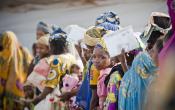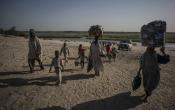Chad
Operation: Chad
Location
{"longitude":19,"latitude":15,"zoom_level":0}
Latest update of camps and office locations 21 Nov 2016. By clicking on the icons on the map, additional information is displayed.
Key Figures
| 2018 planning figures | |
| 100% | of internally displaced households will be living in adequate dwellings |
| 100% | of survivors of sexual and gender-based violence will receive appropriate support |
| 67,500 | children will be enrolled in primary education |
| 62,400 | people of concern will receive inputs or production kits for livelihood activities |
| 13,600 | persons at risk of statelessness will receive identity documents |
| 2016 end-year results | |
| 100% | of reported SGBV survivors received appropriate support |
| 100% | of people of concern to UNHCR had access to primary health care |
| 71% | of registered school-aged refugee children were enrolled in primary education |
| 22,400 | individuals were newly enrolled into management of acute malnutrition programs |
| 3,200 | refugees were submitted for resettlement to third countries |
Latest Updates and Related Links
January - December 2017
People of Concern
17%
Increase in
2016
2016
| 2016 | 554,248 |
| 2015 | 474,478 |
| 2014 | 505,067 |

[["Refugees",391251],["Asylum-seekers",1909],["IDPs",124342],["Returned refugees",28],["Others of concern",36718]]
Loading ...
Chad
< Back
2016
{"categories":[2013,2014,2015,2016,2017,2018],"budget":[200.85624928,227.01880633,171.27878662,162.72600883,165.14580717,148.984743702],"expenditure":[89.65632862,84.18710953,75.37343665,66.52621607,null,null]}
{"categories":[2013,2014,2015,2016,2017,2018],"p1":[188.0295658,227.01880633,168.80272862,159.8415425,161.30406817,140.346386704],"p2":[null,null,1.591058,0.91141933,0.991739,3.003699003],"p3":[null,null,0.885,null,null,null],"p4":[12.82668348,null,null,1.973047,2.85,5.634657995]}
{"categories":[2013,2014,2015,2016,2017,2018],"p1":[87.37685405,84.18710953,73.95915008,64.07941138,null,null],"p2":[null,null,0.60820855,0.62793008,null,null],"p3":[null,null,0.80607802,null,null,null],"p4":[2.27947457,null,null,1.81887461,null,null]}
Loading ...
CHOOSE A YEAR
- 2014
- 2015
- 2016
- 2017
- 2018
Year-end Overview
Plan Overview
Working environment
The difficult socio-economic environment in Chad is expected to continue in 2018. While there is currently no indication of an armed conflict, the biggest threats will likely be terrorism and civil unrest. Socio-economic and political tensions could degenerate into violence and rising criminality.
Furthermore the operational environment is characterized by the conflict and insecurity in the region, including the continuing fight against Boko Haram. The lingering insecurity in the Central African Republic (CAR) may continue to have repercussions on Chad with 1,000 to 5,000 new arrivals planned. Voluntary repatriation will be an unlikely solution in 2018, due to the security concerns in the countries of origin.
Hosting refugees for over 13 years, Chad continues to have a positive and welcoming attitude, evident through the provision of land for agriculture and placement of some teachers in camp schools. In 2018 and 2019 partnerships with regional and local national services will be strengthened to promote ownership of local development plans, particularly in education and health.
Despite Chad acceding to the 1951 Geneva Convention in 1981, a draft national law is yet to be approved. Some 90,000 refugee children born in Chad have not been issued birth certificates, which continues to be a serious protection concern. Heavily influenced by harmful traditional practices which violate basic human rights, predominantly of women and children, combined with a weak judicial system, the protection of refugees remains challenging.
The traditional partnership with CNARR (Commission nationale d’Accueil pour la Réinsertion des Réfugiés et des Rapatriés), UNHCR’s government counterpart will be sustained. Partnerships with national and international NGOs will remain stable at 13. The partnership with WFP will be strengthened in relation to a new profiling exercise which will result in a new joint UNHCR and WFP livelihoods strategy. Pursuing a transition towards solutions for protracted situations, UNHCR will aim to strengthen its partnership with UNDP. Emphasis will be placed on inter-agency coordination activities and bridging the gap with development actors.
Key priorities
In 2018, UNHCR will focus on:
- Improving the quality of life of refugees struggling to combat high levels of mortality, morbidity, and malnutrition through multi-sector interventions, focusing on the most vulnerable, U-5 children and pregnant and lactating women;;
- The inclusion and integration of all sectors into national services, particularly health, water, sanitation and education;
- Increasing water supply through the regular maintenance of existing systems and the introduction of a solar-powered system in the camps in the East;
- Promoting self-reliance through a transitional phase from humanitarian mechanisms to development strategies.
- Concrete measures to facilitate the socio-economic integration of refugees, by gradually integrating refugee schools and health facilities into the national system.





